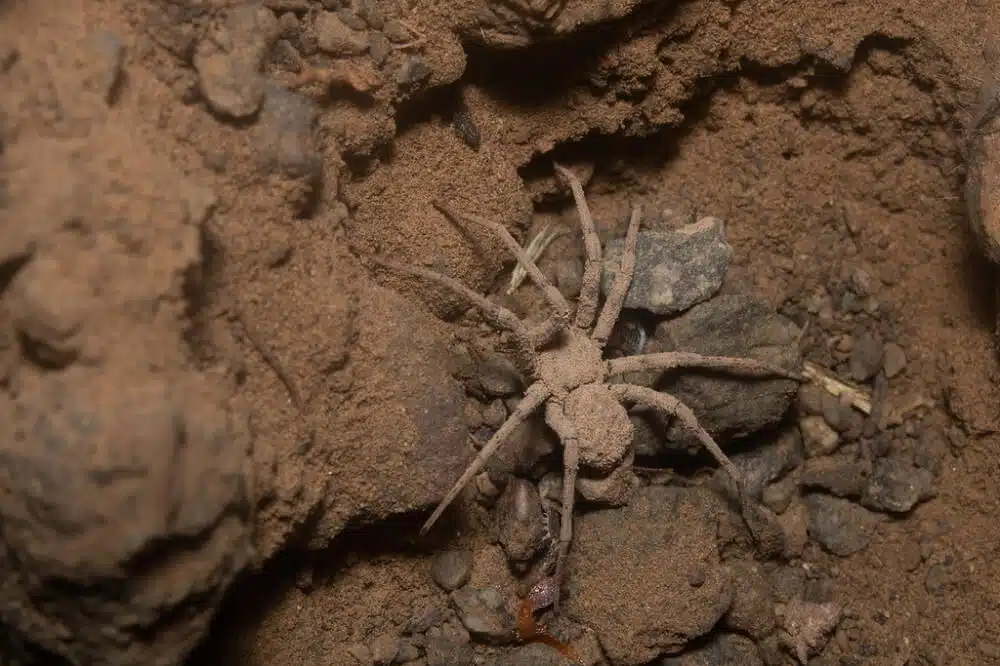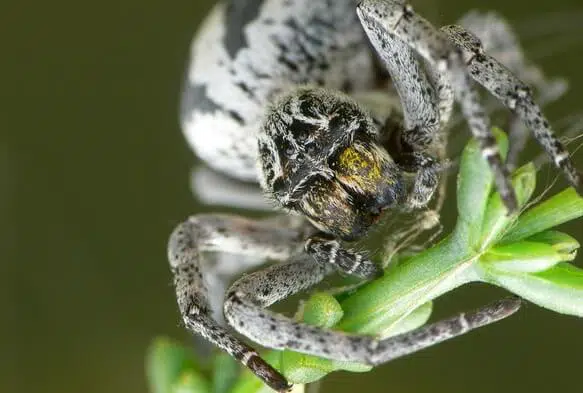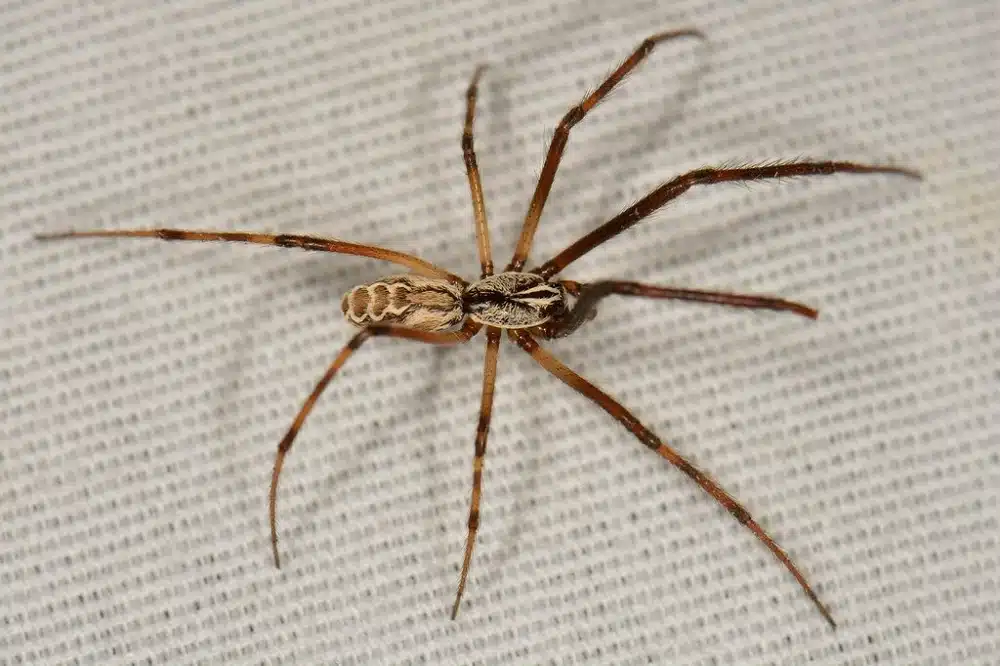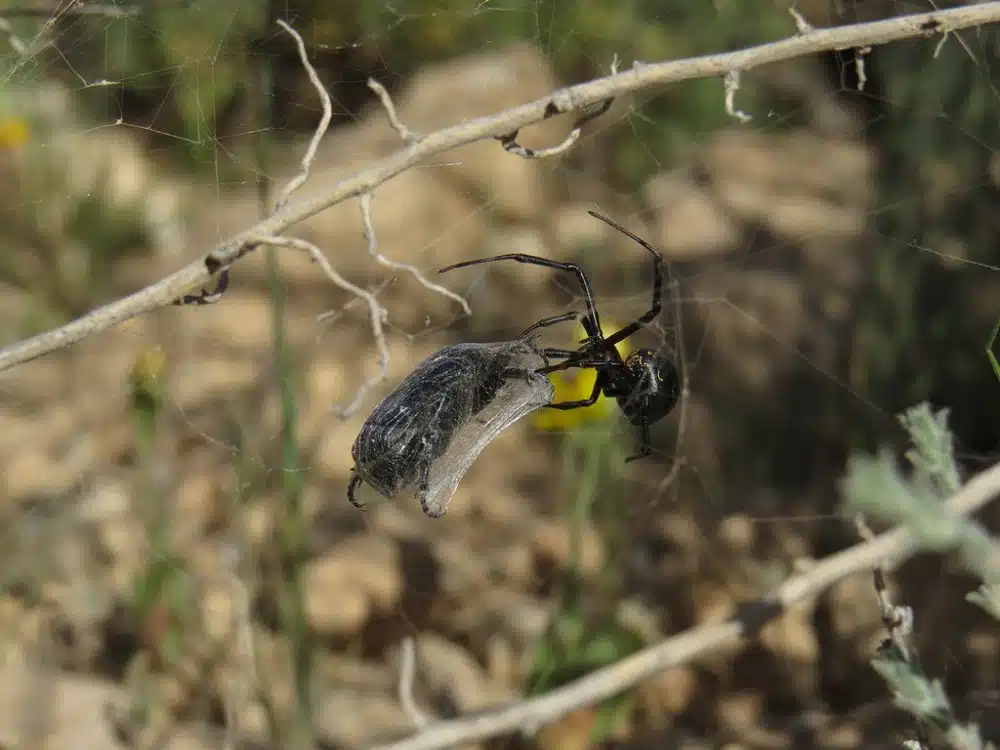Spiders in the desert show adaptations which even include nocturnal feeding.
Unlike spiders in other areas of the world, those in deserts face high temperatures, low humidity, low food availability, and a limited number of shelter options.
This doesn’t mean that spiders don’t live in the desert. Some of the most venomous spiders in the world exclusively live in deserts.
Table of Contents
Desert Spider Adaptations
A hot climate with reduced vegetation and insects is not welcoming for spiders in deserts. Here’s how they manage to survive here.
Burying themselves into the sand
Wheel Spiders and other species of spiders bury themselves deep in the sand to avoid the high heat of the desert.
Some spiders can dig burrows of up to 40 inches, often of a vertical nature, to cool off and escape the high heat of the day. They may stay in their burrows for the entire duration of the day, only coming out at night.
Hiding under rocks
Deserta Grande Wolf Spiders are among the species that only live around rocks and in rocky areas of the desert. This provides some type of quick escape and multiple hiding spots.
Shaded areas and higher moisture areas around rocks also attract various types of prey for these spiders.
Building spider webs undercover
Desert Widows and other types of web-weaving spiders build spider webs in areas with plenty of cover. This keeps them out of the sun and hides them from predators such as birds.
Cover can be represented by various types of vegetation, rocks, or the dunes themselves as they can shelter these spiders in some areas.
Eating ants, termites, millipedes, and scorpions
Food choices might be scarce in the desert, but bugs and insects also live here. From ants to millipedes, spiders can find different types of prey, either by weaving spider webs or by hunting around.
Even larger prey such as lizards and scorpions is considered by the spiders in the desert. Venomous spiders routinely eat large prey, often larger than themselves.
Being nocturnal
By far, the biggest adaptation of spiders to the desert climate is nocturnal activity. Invisible and looking absent from an area during the day, many desert spiders only come out for food at night.
This is also the reason new desert species are just discovered, as they are difficult to capture during the day.
Nocturnal spiders are also fully adapted to communication, even if they have limited vision, as during the day.
Ground and sand vibrations are often communication adaptations for spiders that live in the desert. Still, there are plenty of diurnal spiders that also live in the desert.
Spiders in the Desert
The following species of spiders live in the deserts of the world.
1. Desert Tarantula

The Desert Tarantula (Aphonopelma iodius) is highly common in Arizona and Mexico.
Only found in the deserts of the state and not in other states, this is a species that has multiple other names, most impacted by its US-Mexico border range.
This is why, in Arizona, it can be known as The Arizona Tarantula. In Mexico, it can be known as the Mexican Tarantula.
Even more, it’s also nicknamed The Blonde Tarantula, for it mostly has bright hairs.
Only showing a brown abdomen, this is also a species that’s common in captivity, as it’s not venomous.
A typical Desert Tarantula grows to a size of 4-5 inches and can live years or even decades.
2. Desert Blonde Tarantula

Desert Blonde Tarantulas (Aphonopelma chalcodes) are native to the deserts of the Southwestern US, mostly to Arizona.
This is a species with bright hairs along the legs and carapace and brown hairs covering its abdomen.
In the US, The Desert Blonde Tarantula is known as The Arizona Blonde Tarantula.
While this name would imply the species is only present in Arizona, it also lives in the areas of the desert in Mexico.
It can also be a good species for captivity but The Desert Blonde Tarantula lives slightly shorter lives of up to 8 years while only the females live more than a few decades.
This tarantula is also ideal for beginner tarantula owners as it can be raised in a simple enclosure with a deep substrate at room temperature.
3. Desert Grass Spider

Native to The Southwestern US deserts, this (Agelenopsis aperta) is a banded and striped spider.
Its legs show black bands while its carapace and abdomen show black stripes. A ground sand color is specific to these spiders.
The Desert Grass Spider lives both in deserts and in grasslands or woodlands.
It has no predators in the desert to worry about as opposed to grasslands.
This is also a spider that survives on insects, often showing the capacity to hunt at night.
Spiders of this genus also pick on the prey that is easiest to kill so they don’t spend too much time and energy chasing it.
4. Desert Recluse

A venomous species of the Southwestern United States, The Desert Recluse (Loxosceles deserta) is common in deserts but it’s rarely spotted in homes or man-made structures here.
However, this spider may still bite, often with a painful effect.
The venom of the spider may not kill humans but it may cause swelling, red skin, and even deeper skin lesions that last for days.
Mostly tan and brown, The Desert Recluse has very long legs in proportion to its body.
This is also a species that has a very atypical habitat in the desert. It mostly lives around rodent dens where it can find both food and shelter.
5. Carolina Wolf Spider

These types of spiders actively look around for prey instead of building spider webs.
Carolina Wolf Spiders (Hogna carolinensis) are among the most adaptable types of spiders in North America as they can live in most habitats, including deserts.
If they can survive on cockroaches indoors, they can also eat small insects and other spiders in the desert.
As the largest type of wolf spider in North America, Carolina Wolf Spiders are also among the strongest when it comes to overpowering even larger prey in the desert, including scorpions.
While their color can vary, these spiders are often brown, bright brown, or bright gray when in the desert.
6. Mojave Dwarf Tarantula

A species of The Mojave Desert, this small type of tarantula (Aphonopelma mojave) only grows to a couple of inches.
Found in rocky areas of the desert, it repurposes old burrows or looks for places it can crawl into the ground.
Brown and gray nuances are specific to males while females are mostly black and brown.
The only colorful area of its body is its legs. In rare cases, The Mojave Dwarf Tarantula is mostly dark brown.
7. Homalonychus selenopoides

This sand color type of spider is native to The Sonoran Desert.
Little color variation is seen within the species which tries to mimic the color of its surroundings to stay clear of predators.
Males and females adapt their sandy surroundings to their breeding habits.
The male uses sand grains to spin threads which are passed to the female which then spins the egg sacs in a reinforced manner when the sand grains add structural strength.
No other species outside the Homalonychidae can attach sand to themselves in North America.
8. Phidippus octopunctatus

This type of spider is found in The Great Basin Desert as well as outside the desert climate.
It features a bright abdomen and carapace and black legs with additional black areas around the sides.
A large type of spider, this species is known for the appearance of its males. The female Phidippus octopunctatus is dominated by bright nuances and sand colors across the body and the legs.
Spiders of this family are jumping spiders, which means they pounce on prey.
They can eat different types of insects, including bees and wasps.
Some of their more atypical meals are represented by bugs.
9. Wheel Spider

Africa’s Namib Desert and the oldest desert in the world is home to The Wheel Spider (Carparachne aureoflava).
Much of the life of this atypical spider is influenced by the desert and its arid climate.
As a nocturnal species, Wheel Spiders only come out at night. Despite this, they still have a pale sandy color to avoid easily being spotted by predators.
Wheel spiders survive the acute conditions of The Namib Desert by burying themselves in the sand.
They remain deep in the sand, especially during the day when the temperatures are at their highest.
To avoid getting tangled in fine sand, these spiders build small silk burrows they live in underground.
Despite their size, these small spiders can move buckets of sand to get underground and build their silk nests.
10. Dancing White Lady

Dancing White Lady spiders (Leucorchestris arenicola) also live in The Namib Desert. Often confused with Wheel Spiders, they also share the same habitat and some types of habits.
Like Wheel Spiders, Dancing Spiders hide in the sand to escape the high desert heat.
They create long burrows which can measure 10 or more inches deep in the sand to create a cool shaded habitat to retreat in during the day.
Unlike Wheel Spiders that always line their nests with silk, Dancing White Ladies only occasionally line their nests with silk, mainly when they need to add structural integrity to their burrows.
These spiders don’t build spider webs either, they come out at night, looking for food.
Bugs and insects such as weevils are all part of their diet, as these spiders can eat almost any type of bug in the desert.
Even more, these spiders tend to dig their burrows rather close to other Dancing Whit Ladies, mostly for breeding purposes.
As a result, males exit their burrows at night, looking for a female partner.
In some cases, they find the female quickly. In others, they rely on tapping movements and sand vibrations to communicate their location.
There are very specific vibrations they make as males may also end up being eaten by the female.
11. Stegodyphus lineatus

The Negev Desert in the Southeastern parts of Israel is home to this spider species.
A black and white type of spider, this bulbous-looking species is one of the spiders of the desert that builds spider webs.
It always builds these webs around the scarce vegetation in The Negev Desert as it’s likely to attract insects and bugs.
Pollinators get trapped in their spider webs, ensuring their prey is ready to be eaten without even leaving the spider web.
These spiders do live in the spider web for breeding, on the other hand.
Males are the ones that initiate the breeding process, typically by visiting the spider web of a female and tapping on it.
This is also the period when the female starts to grow larger than the male. Females entering the breeding period eat more and even become larger.
12. Moroccan flic-flac spider

Found on the dunes of Morroco, this type of spider is named after its highly atypical movement method.
It rolls backward and forwards, instantly becoming faster. These types of flic-flac movements are used when the spider escapes a dangerous situation or when it needs to climb.
Moroccan flic-flac spiders (Cebrennus rechenbergi) are among the species that burrow themselves in the sand during the day.
Vertical burrows lined or not lined with silk threads are specific to the species.
The Moroccan flic-flac spider uses its flic-flac movements to climb out of its vertical burrow at night, a moment when it becomes active and looks for food.
Most of their diet is based on moths as they are found in high numbers here.
The capacity of these spiders to move very fast on sand means they can also cover larger distances when looking for food at night before sunrise.
13. Desert Bush Spider

Desert Bush Spiders (Diguetia canities) are named after the short vegetation they live around in the Southwestern US deserts.
Also found in Mexico, The Desert Bush Spider is a pale species with a sand-like carapace and abdomen and darker legs, which are almost brown with black spots or marks.
The Desert Bush Spider is a web-building species of the desert.
It builds specific cone-shaped spider webs which serve multiple purposes.
First, these spider webs help trap insects that visit the flowers they live around. Secondly, these spider webs are also where the female lays the egg sac.
This egg sac isn’t laid on any part of the web, on the other hand. There’s a tubular section of the web in its central part which serves as a spot for egg sacs with additional protection from potential predators.
14. Six-eyed Sand Spider

With a preference for deserts, The Six-eyed Sand Spider (Sicarius thomisoides) is also found in African deserts, particularly in Namibia.
This is a large spider with crab-like legs and a sand color which is mostly tan or gray with tiny brown spots on the dorsum.
Six-eyed Sand Spiders are venomous but their bites are rare, given they live in actual deserts.
The venom of the species is necrotic and while bite reports are rare, they do note that skin necrosis is a direct result of its bite.
In most cases, the symptoms of its bite go away on their own. Medical attention is still required following its bite as complications may lead to death.
Complications include severe allergic reactions as well as infections.
15. Chilean Rosehair Tarantula

While it’s called a Chilean tarantula, this species (Grammostola rosea) is also found outside The Chilean deserts in Argentina and Bolivia.
Named after the rose nuance of its hairs, this is a type of tarantula that survives deserts through its burrowing tendencies.
This is a species that digs deep or that uses the burrows of other species as their nests.
Males tend to cover up their nests while females prefer to dig a bit deeper for extra safety.
These types of tarantulas are large and have a comprehensive diet that includes lizards.
Most commonly, Chilean Rosehair Tarantulas catch insects and bugs that land next to their burrows. This includes moths and crickets.
While each of these tarantulas lives in an underground burrow, they often live close to each other for breeding purposes.
This is why multiple Chilean Rosehair Tarantula burrows are found close to each other.
Despite their venomous nature, these tarantulas are docile and common as pets, especially since they can go without food for months.
16. Redback Spider

Native to the deserts of Australia, Redback Spiders (Latrodectus hasselti) are among the most venomous species of the deserts.
Often found next to homes, in homes, and especially in The Simpson Desert, this species survives by having a varied diet.
Redback Spiders even eat small lizards. On the other hand, there are large spider species that feed on this venomous spider as well.
Identified by their black color and red abdominal stripe, these types of spiders use various techniques to catch prey.
A spider web is just one of them. A venomous bite and the ability to tire out prey are also used.
Redback Spiders live their insects struggle on spider webs before approaching for the first bite.
The venomous bite of the species is also highly potent and even dangerous to humans or animals.
In some of the most extreme documented bite cases, antivenin was given to patients that made it to the hospital.
17. Deserta Grande Wolf Spider

A species of The Desert Grande Island of Madeira, The Deserta Grande Wolf Spider (Hogna ingens) is one of the rarest types of desert spiders in the world.
Living in arid conditions on a remote island, The Desert Grande Wolf Spider is only believed to survive in a few thousand individuals.
Closely found to vegetation in these sandy areas, The Deserta Grande Wolf Spider is a species that feeds on small insects that survive in this habitat.
The species also impresses with its size. Its legspan can measure up to 5 inches, which makes it one of the largest spiders in the world.
Apart from its notable wolf spider size, this is also a species that delivers a venomous bite that’s highly painful.
A combination of remote habitats and low populations is what makes this species less dangerous than others.
Large spiders of the genus are among the spiders that are nearly extinct and are often subject to repopulation methods.
18. Aelurillus desertus

This type of spider has only been recently categorized. Endemic to The United Arab Emirates, it’s a type of striped spider of the desert.
Spiders of this family are small, with males growing to 0.1 inches and females growing to 0.9 inches.
Believed to live in small numbers of only thousands, this is a spider that jumps.
It pounces on prey and it jumps to cover distances further.
Rocky areas of the desert are among its favorites, as it’s here that it can find food and shelter.
Unlike other types of jumping spiders in the area, this species also shows a bright stripe across the abdomen.
It does show short white-gray hairs across its body and legs, similar to other jumping spiders.
19. Desert Widow

A black spider with brown or golden-brown marks on the abdomen, The Desert Widow (Latrodectus revivensis) is a venomous spider and a rare sight.
Part of the Latrodectus genus, this is one of the most venomous spiders in the world, often being a cause of concern with death, especially in the case of bite complications.
Desert Widows spin spider webs in the desert, especially in areas with bushes or overhead cover.
These types of spiders eat different types of insects and bugs caught up in their webs.
Scorpions may also be eaten by adult Desert Widows.
As with many species of venomous spiders, Desert Widows are often prey for larger predators themselves.
One way for the spider to avoid predation and to survive deserts is to favor areas with bushes or rock cover instead of living out in the open where it can be easily spotted by birds.